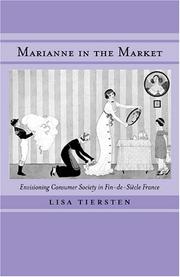| Listing 1 - 2 of 2 |
Sort by
|

ISBN: 0520225295 0520925653 9786612356353 1282356356 1597347353 9780520925656 9781597347358 9780520225299 9781282356351 Year: 2001 Publisher: Berkeley University of California press
Abstract | Keywords | Export | Availability | Bookmark
 Loading...
Loading...Choose an application
- Reference Manager
- EndNote
- RefWorks (Direct export to RefWorks)
In the late nineteenth century, controversy over the social ramifications of the emerging consumer marketplace beset the industrialized nations of the West. In France, various commentators expressed concern that rampant commercialization threatened the republican ideal of civic-mindedness as well as the French reputation for good taste. The female bourgeois consumer was a particularly charged figure because she represented consumption run amok. Critics feared that the marketplace compromised her morality and aesthetic discernment, with dire repercussions for domestic life and public order. Marianne in the Market traces debates about the woman consumer to examine the complex encounter between the market and the republic in nineteenth-century France. It explores how agents of capitalism-advertisers, department store managers, fashion journalists, self-styled taste experts-addressed fears of consumerism through the forging of an aesthetics of the marketplace: a "marketplace modernism." In so doing, they constructed an image of the bourgeois woman as the solution to the problem of unrestrained, individualized, and irrational consumption. Commercial professionals used taste to civilize the market and to produce consumers who would preserve the French aesthetic patrimony. Tasteful consumption legitimized women's presence in the urban public and reconciled their roles as consumers with their domestic and civic responsibilities. A fascinating case study, Marianne in the Market builds on a wide range of sources such as the feminine press, decorating handbooks, exposition reports, advertising materials, novels, and etiquette books. Lisa Tiersten draws on these materials to make the compelling argument that market professionals used the allure of aesthetically informed consumerism to promote new models of the female consumer and the market in keeping with Republican ideals.
Women consumers --- Consumption (Economics) --- Middle class --- Aesthetics, Modern --- Consommatrices --- Consommation (Economie politique) --- Bourgeoisie --- Esthétique moderne --- History --- Histoire --- France --- Economic conditions --- Civilization --- Conditions économiques --- Civilisation --- 19th century. --- Consumption (Economics). --- Consumption (Economics) - France - History - 19th century. --- France. --- History. --- Middle class. --- Middle class - France - History - 19th century. --- Women consumers. --- Women consumers-- France-- History-- 19th century. --- Business & Economics --- Economic History --- Esthétique moderne --- Conditions économiques --- Aesthetics --- Commons (Social order) --- Middle classes --- Consumer demand --- Consumer spending --- Consumerism --- Spending, Consumer --- Women as consumers --- Social conditions --- Social classes --- Demand (Economic theory) --- Consumers --- E-books --- advertising. --- aesthetics. --- bourgeoisie. --- capitalism. --- commercialization. --- consumer culture. --- department stores. --- domesticity. --- economics. --- etiquette books. --- fashion. --- female bourgeois. --- female consumer. --- female morality. --- france. --- french culture. --- french republic. --- french women. --- gender roles. --- gender studies. --- gender. --- good taste. --- la belle epoque. --- nonfiction. --- republican. --- women. --- womens studies.
Book
ISBN: 9780520267855 9786613520586 0520950313 9780520950313 1280103876 9781280103872 0520267850 Year: 2012 Publisher: Berkeley, Cailf. University of California Press
Abstract | Keywords | Export | Availability | Bookmark
 Loading...
Loading...Choose an application
- Reference Manager
- EndNote
- RefWorks (Direct export to RefWorks)
Since its early days of mass production in the 1850s, the sewing machine has been intricately connected with the global development of capitalism. Andrew Gordon traces the machine's remarkable journey into and throughout Japan, where it not only transformed manners of dress, but also helped change patterns of daily life, class structure, and the role of women. As he explores the selling, buying, and use of the sewing machine in the early to mid-twentieth century, Gordon finds that its history is a lens through which we can examine the modern transformation of daily life in Japan. Both as a tool of production and as an object of consumer desire, the sewing machine is entwined with the emergence and ascendance of the middle class, of the female consumer, and of the professional home manager as defining elements of Japanese modernity.
Sewing-machine industry --- Clothing trade --- Consumers --- J4300.80 --- J4456 --- J4520 --- Customers (Consumers) --- Shoppers --- Persons --- Apparel industry --- Clothiers --- Clothing industry --- Garment industry --- Rag trade --- Textile industry --- Tailors --- Machinery industry --- History --- Japan: Economy and industry -- history -- Gendai (1926- ), Shōwa period, 20th century --- Japan: Economy and industry -- manufacturing and production -- household consumer products --- Japan: Economy and industry -- commerce and trade -- retail and consumption --- Singer Sewing Machine Company --- Singer Manufacturing Company --- Singer Company --- History. --- Sewing machines --- Clothing factories --- Machine sewing --- Equipment and supplies --- E-books --- Fashion industry --- Consumers - Japan - History - 20th century. --- 19th century japan. --- 19th century women. --- business infrastructure. --- company business profiles. --- consumerism history. --- corporate innovation. --- dress and textiles. --- east asia. --- fashion and clothing. --- female consumer. --- history of anthropology. --- history of capitalism. --- history of fashion. --- japan social history. --- japanese class structure. --- japanese females. --- japanese history. --- japanese role of women. --- japanese women. --- middle class. --- modern japan. --- sewing machine history. --- socioeconomic change. --- western dress. --- women in workplace.
| Listing 1 - 2 of 2 |
Sort by
|

 Search
Search Feedback
Feedback About UniCat
About UniCat  Help
Help News
News